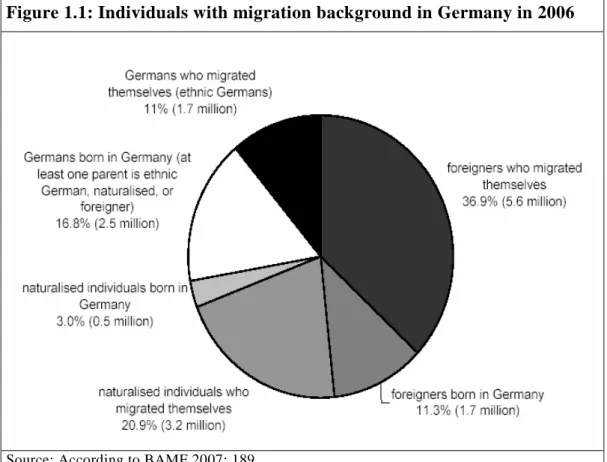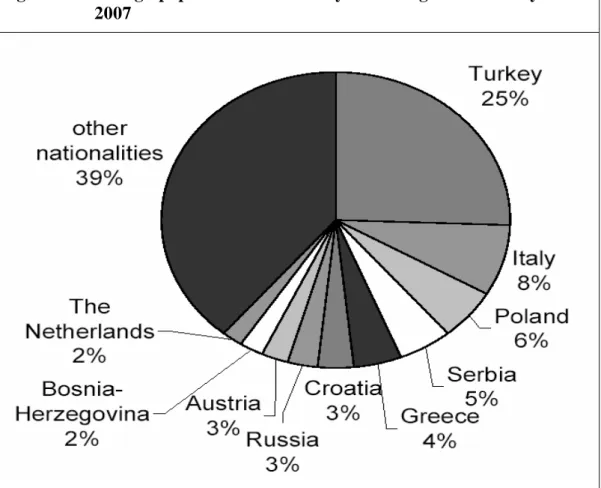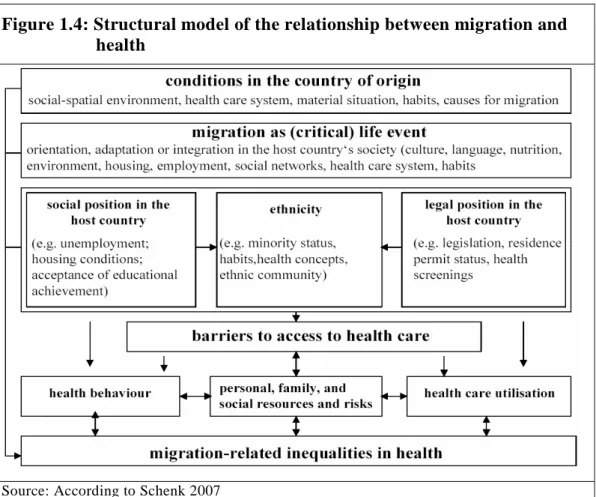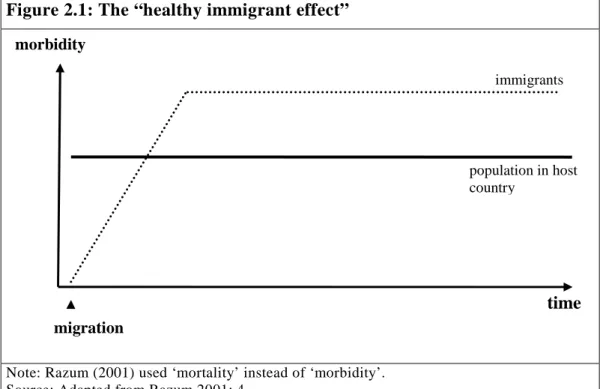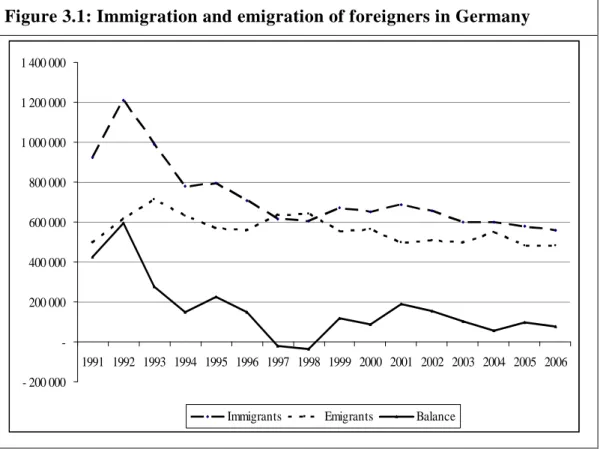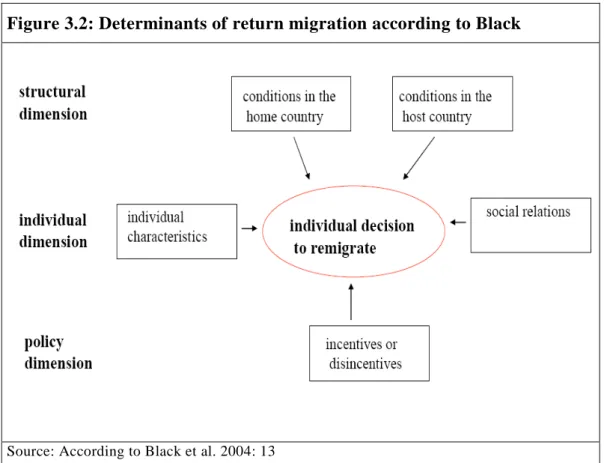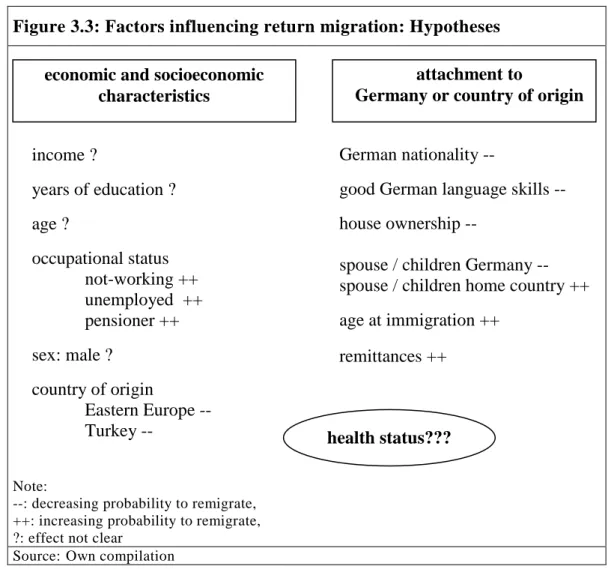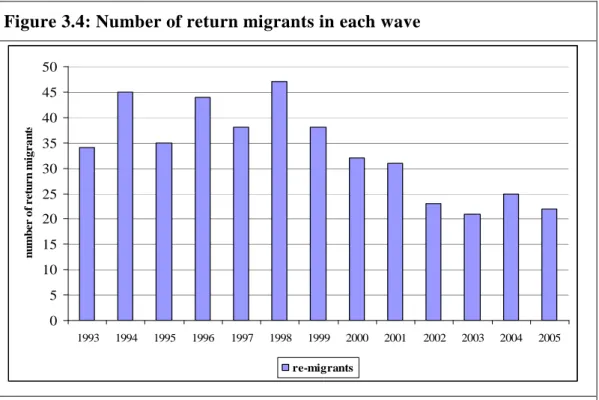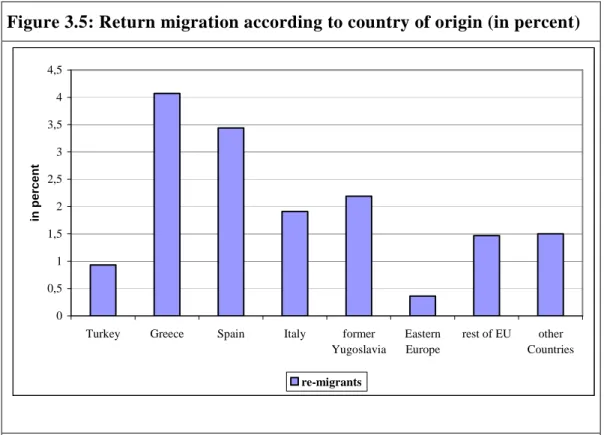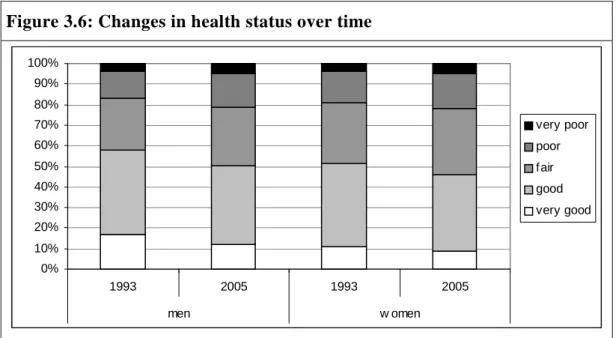Migration and Health –
Empirical Analyses based on the German Socio-Economic Panel Study
(SOEP)
INAUGURAL-DISSERTATION
zur Erlangung des akademischen Grades eines doctor rerum politicarum (Dr. rer. pol.)
an der Fakultät
Sozial- und Wirtschaftswissenschaften der
Otto-Friedrich-Universität Bamberg
vorgelegt von
Diplom-Volkswirtin Monika Sander
Erstgutachter: Prof. Dr. Johannes Schwarze
Zweitgutachterin: Prof. Dr. Henriette Engelhardt-Wölfler Tag der mündlichen Prüfung: 10.06.2009
Acknowledgement
The realisation of this dissertation would not have been possible without the kind support of a number of people to whom I would like to express my gratitude. First of all, I am deeply grateful to my supervisor Johannes Schwarze for his continuous support during the last couple of years. He steadily encouraged my work with lots of ideas and criticism. I would also like to thank Henriette Engelhardt-Wölfler for her advice and complementary guidance. Furthermore, I am highly indebted to Christoph Wunder for comments on earlier drafts as well as for helping me to take many hurdles, especially in the early stage of the project. This thesis has also benefited from many comments and suggestions by Ivonne Honekamp, Irena Kogan, and many participants at various conferences and workshops. In addition, I gratefully acknowledge financial support from the German Research Foundation.
My sincere thanks goes to my colleagues at the Graduate School “Markets and Social Systems in Europa”, University of Bamberg. Especially, I would like to thank Anna Fräßdorf, Ruth Kamm, Tadeusz Kantor, Tomas Marttila, Eva Ruffing, Henrik Schillinger, and Christian Schmidt-Wellenburg for nice lunchs and evenings, table tennis matches, as well as their constant moral support.
Furthermore, I thank my parents for their continuous support and encouragement. Finally, I am deeply thankful to Mathias. He was simply present when I needed it most.
Table of Content
List of Tables ... 7
List of Figures ... 9
List of Acronyms ...10
Executive Summary ...12
1 Introduction ...16
1.1 General motivation
... 161.2 Migration to Germany
... 191.2.1 Phases of immigration to Germany
... 191.2.2 Immigrants in Germany
... 221.3 Migration and health
... 271.3.1 The health situation of immigrants
... 271.3.2 Determinants of immigrants’ health
... 281.4 Selection of the database
... 322 The “healthy immigrant effect” ...37
2.1 Definition of the HIE and differentiation from the “Hispanic Paradox”
... 372.1.1 Mortality Studies: Hispanic Paradox and Salmon Bias
.... 382.1.2 Morbidity studies: The “healthy immigrant effect”
... 402.2 Literature review
... 432.3 Possible explanations for the HIE
... 472.3.1 First part of the HIE: Immigrants’ better health upon arrival
... 472.3.2 Second part of the HIE: Subsequent decline in immigrants’ health
... 502.4 Concluding comments
... 543 Return migration and the “healthy immigrant effect” ...56
3.1 Introduction
... 563.2 Theories of return migration
... 583.3 Previous empirical findings on return migration
... 623.4 Data and estimation method
... 683.4.1 Data
... 683.4.2 How to measure health?
... 693.4.3 Sample design
... 713.4.4 Dependent variable
... 723.4.5 Independent variables
... 733.4.6 Characteristics of the sample population
... 753.4.7 Econometric specification
... 803.5 Estimation results
... 833.5.1 Estimation results with regard to self-rated health
... 833.5.2 Estimation results with regard to hospital stays
... 903.5.3 Estimations results with regard to disability
... 933.5.4 Estimation results for the Mundlak approach
... 953.5.5 Approach to family interdependencies
... 983.6 Conclusion and discussion
... 1014 The health behaviour of immigrants ...103
4.1 Introduction
... 1034.2 Theories of health behaviour
... 1044.3 Previous empirical findings
... 1054.4 Data and estimation method
... 1094.4.1 Data
... 1094.4.2 Empirical strategy
... 1104.4.3 Dependent variables
... 1124.4.4 Independent variables
... 1214.5 Estimation results
... 1234.5.1 Body Mass Index
... 1234.5.2 Alcohol consumption
... 1304.5.3 Smoking
... 1354.6 Conclusion and discussion
... 1415. Immigrants’ access to health care and utilisation of health care services ...144
5.1 Introduction
... 1445.2 Theories of health care utilisation
... 1465.2.1 Grossman model
... 1465.2.2 Andersen’s behavioural model of health service use
... 1485.3 Principles of equity in health care
... 1545.4 Literature review
... 1595.5 Data and econometric method
... 1615.5.1 Data
... 1615.5.2 Empirical specification: Count data models
... 1625.5.3 Design of the sample
... 1715.5.4 Dependent variable
... 1725.5.5 Independent variables
... 1735.5.6 Descriptive characteristics of the sample
... 1745.6 Estimation results
... 1785.6.1 Estimation results for the contact decision
... 1785.6.2 Estimation results for the frequency decision
... 1875.7 Conclusion and discussion
... 1926. Summary and conclusion ...195
Appendix ...201
References ...208
List of Tables
Table 3.1: Descriptive characteristics of the sample in 1993 & 2005 ... 78
Table 3.2: Descriptive characteristics of return migrants ... 79
Table 3.3: Determinants of return migration: Estimation results with regard to self-rated health ... 89
Table 3.4: Determinants of return migration: Estimation results with regard to hospital stays... 92
Table 3.5: Determinants of return migration: Estimation results with regard to disability... 94
Table 3.6: Determinants of return migration: Estimation results for the Mundlak approach ... 97
Table 3.7: Approach to family interdependencies: Estimation results ... 100
Table 4.1: Estimation results: BMI, total sample ... 127
Table 4.2: Estimation results: BMI, only men... 128
Table 4.3: Estimation results: BMI, only women... 129
Table 4.4: Estimation results: Alcohol consumption, multilevel logistic model ... 134
Table 4.5: Estimation results: Smoking, total sample... 138
Table 4.6: Estimation results: Smoking, only men ... 139
Table 4.7: Estimation results: Smoking, only women ... 140
Table 5.1: Doctor visits: Descriptive analysis ... 173
Table 5.2: Descriptive characteristics of the sample... 177
Table 5.3: Estimation results for first-generation immigrants: First part of the hurdle model: Random-effects probit model ... 185
Table 5.4: Estimation results for second-generation immigrants: First part of the hurdle model: Random-effects probit model ... 186
Table 5.5: Estimation results for the second-generation, multilevel model ... 187
Table 5.6: Estimation results: First-generation immigrants: Second part of the hurdle model: Zero-truncated negative binomial model ... 190
Table 5.7: Estimation results: Second-generation immigrants: Second part of the hurdle model: Zero-truncated negative binomial model... 191
Table 5.8: Summary of the results with regard to language skills and ysm ... 193
Table A1: Sample characteristics of table 4.1 ... 202
Table A2: Sample characteristics of table 4.4 ... 203
Table A3: Sample characteristics of table 4.5 ... 204 Table A4: Estimation results, first part of the hurdle model, first-generation,
language index ... 205 Table A5: Estimation results, first part of the hurdle model, first-generation,
with the inclusion of religion... 206 Table A6: Estimation results, fixed-effects logit model for first-generation
immigrants ... 207
List of Figures
Figure 1.1: Individuals with migration background in Germany in 2006 ... 23
Figure 1.2: Foreign population in Germany according to nationality in 2007 . 24 Figure 1.3: Duration of residence according to nationality in 2007 ... 25
Figure 1.4: Structural model of the relationship between migration and health ... 30
Figure 1.5: Influence factors on migrants’ health during the life course... 31
Figure 2.1: The “healthy immigrant effect” ... 41
Figure 3.1: Immigration and emigration of foreigners in Germany... 57
Figure 3.2: Determinants of return migration according to Black ... 62
Figure 3.3: Factors influencing return migration: Hypotheses... 66
Figure 3.4: Number of return migrants in each wave ... 72
Figure 3.5: Return migration according to country of origin (in percent)... 73
Figure 3.6: Changes in health status over time... 77
Figure 4.1: Hierarchical structure of the data ... 111
Figure 4.2: Health-conscious diet according to gender and years since migration ... 113
Figure 4.3: Never taking part in sport activities by gender and years since migration ... 114
Figure 4.4: Distribution of overweight and obese according to age and years since migration for men ... 117
Figure 4.5: Distribution of overweight and obese according to age and years since migration for women ... 117
Figure 4.6: Percentage of abstainers by gender and years since migration .... 119
Figure 4.7: Smoking behaviour according to gender and years since migration ... 121
Figure 5.1: The behavioural model of Andersen ... 149
Figure 5.2: Relationship between barriers to access in health care and utilisation ... 156
Figure A1: Regional share of foreigners in Germany ... 201
List of Acronyms
AIC Akaike's Information Criterion
AIDS Acquired Immunodeficiency Syndrome
BAMF Bundesamt für Migration und Flüchtlinge [Federal Office for Migration and Refugees]
BBR Bundesamt für Bauwesen und Raumordnung
[Federal Office for Building and Regional Planning]
BMI Body Mass Index
CCHS Canadian Community Health Survey
DIW Deutsches Institut für Wirtschaftsforschung [German Institute for Economic Research]
EHA Event-History Analysis
EU European Union
FE Fixed Effects
GDP Gross Domestic Product
GDR German Democratic Republic
GSS General Social Survey
HIE Healthy Immigrant Effect
HIV Human Immunodeficiency Virus
i.i.d. Independent, identically distributed
IV Instrumental Variable
KiGGS Kinder- und Jugendgesundheitssurvey [German Health Interview and Examination Survey for Children and Adolescents]
LC Latent Class
LSIA Longitudinal Survey of Immigrants to Australia
MQL Marginal Quasi-Likelihood
MxFLS Mexican Family Life Survey
Negbin Negative Binomial Model
NHIS National Health Interview Survey
NIS New Immigrant Survey
NIS-P New Immigrant Pilot Survey
NLMS National Longitudinal Mortality Study
NPHS National Population Health Survey
PQL Predictive Quasi-Likelihood
PRM Poisson Regression Model
RE Random Effects
RKI Robert Koch-Institut
SOEP German Socio-Economic Panel Study
SHARE Survey on Health, Ageing and Retirement in Europe
SRH Self-rated Health
VPC Variance Partition Coefficient
WHO World Health Organisation
YSM Years Since Migration
ZINB Zero-Inflated Negative Binomial
ZIP Zero-Inflated Poisson
Executive Summary
The so-called “healthy immigrant effect” (HIE) is one of the most striking findings concerning immigrants and their health status. It is usually said to consist of two parts: According to the first part, immigrants upon arrival are on average healthier than their native peers. This finding is mostly explained by self-selection among their origin population. The idea is that healthier individuals are more likely to migrate as they are more able to reap the reward of the ‘investment migration’ than less healthy individuals. However, according to the second part, this health gap between immigrants and natives closes after a relatively short period of time, and the health of immigrants is converging to that of the natives or is getting even worse. This gradient of immigrants’ health has been found in many countries (e. g., Australia, Canada, and United States) and for many different measures of health (e. g., self-rated health, chronic diseases). The causes for this decline in immigrants’ health are subject to ongoing research, but the underlying trajectories are not yet fully understood. In literature, there are several different explanations discussed:
The adoption of destination-country habits and lifestyles, the structural and material relationship between a low socio-economic status and poor health, additional stress due to the migration process, persistent barriers to access to health care due to cultural or language factors, as well as a kind of “statistical artefact” explanation due to selection effects caused by return migration. As health is a rather complex concept one can assume that none of the proposed explanations can solely explain the decline in immigrants’ health, but rather that the health deterioration is a result of different interacting causes.
This thesis investigates three of the proposed possible explanations for a decline in immigrants’ health, namely return migration (chapter 3), the adoption of destination-country habits and lifestyles (chapter 4), and immigrants’ access to health care and utilisation of health care services (chapter 5). The results of these chapters are shortly summarised in the following.
The data are drawn from the German Socio-Economic Panel Study (SOEP), a longitudinal representative study of individuals and private households in Germany. Hence, throughout the study, panel data are used, which offer the possibility to take time-constant individual-specific heterogeneity into account.
This allows, for instance, controlling for different behavioural attitudes, health beliefs, preferences, risk aversion, or genetic frailty.
In chapter 3 the role of health in return migration is investigated using thirteen waves (1993-2005) of the SOEP. The idea with regard to the HIE is that the decline in immigrants’ health can additionally be caused by a kind of
“statistical artefact” in the way that if healthier immigrants are more likely to remigrate, the average health of the remaining immigrants will decrease.
Overall, the results indicate that men in poorer health (measured through self- rated health, disability, and hospital visits) are significantly less likely to return home relative to healthier immigrants. For women, no clear results for the influence of health on return migration are found. Overall, at least for men, selection effects caused by return migration of healthier men might contribute to the deterioration of immigrants’ health over time.
Chapter 4 analyses a possible contribution of a change in immigrants’ health behaviour (especially, the Body Mass Index (BMI), alcohol consumption, and smoking) with duration of residence in Germany to the decline in immigrants’
health. The idea behind is that immigrants’ change there former healthy behaviour and adopt – in the course of acculturation – the life style of their host country, which is assumed to be more harmful to health.
With regard to the BMI – drawing on three waves (2002, 2004, and 2006) of the SOEP – it is found that the BMI increases with additional years in Germany for men and women. Thereby, the idea that changes in lifestyle and environment might lead to a weight gain can be supported. Regarding the potential influence of an increase in the BMI to the deterioration of immigrants’ health with years since migration it can be concluded that a weight gain might indeed contribute to the decline in health.
For alcohol consumption only a cross-section analysis can be carried out as the question has only been included in one wave (2006) of the SOEP. It can be
shown that an additional year in Germany increases the probability of being abstinent. However, none of the estimated coefficients is significant.
For smoking, duration of residence is found to have a different influence on the smoking probability for men and women. For men, the coefficient of years since migration is negative, but not significant. Taking into account, that in many immigrant source countries, the smoking probability is higher than in Germany, this can be interpreted as support for the acculturation hypotheses.
Thereby acculturation comes along with ‘good’ health behaviour, a possibility which has been rather neglected in the existing literature. Therefore, in future studies on health behaviour, more attention should be drawn on the possibility of a positive change in the health behaviour (at least for smoking). For women, it is found that the probability of smoking increases with additional years of residence in Germany. As the smoking prevalence for women is in most of the immigrant source countries smaller than for Germany, this finding can again be interpreted as support for the acculturation hypothesis.
In chapter 5 immigrants’ access to health care and utilisation of health care services is analysed. Thereby, it is investigated if there is inequity in access to or in the utilisation of health care services due to a lack of language skills or due to a lack of information about the health care system (approximated by years since migration) among first- and second-generation immigrants in Germany. The data used are drawn from eleven waves of the SOEP (1995- 2006).
With regard to the probability to contact a physician (as a proxy for access), German language skills are found to have no significant influence for all groups of immigrants. The hypothesis of inequity in access to health care due to access barriers caused by a lack of German language skills is therefore not supported by the data. However, mother tongue language skills seem to be important for the contact probability of the first- and second-generation:
Having only good or poor mother tongue language skills reduces the probability of a doctor contact. The effect is found to be significant for first- and second-generation men. This might be explained by the fact that immigrants could go to doctors speaking their mother tongue, but having only poor language skills in the mother tongue hampers this possibility. For the
frequency of doctor visits (utilisation), poor German language skills are found to exert a significant influence – in contrast to the contact decision: Those reporting poor language skills have a lower expected number of doctor visits.
The effect is found to be significant for first-generation men and for second- generation men and women. Hence, there seems to be inequity in health care utilisation due to lacking German language skills. With the exception of first- generation men – where it is found that poor mother tongue language skills reduce the expected number of doctor visits significantly, no significant effect is found for mother tongue language skills.
With regard to the duration of residence, the results indicate that years since migration have an impact on the contact decision of first-generation immigrant women, whereby a significant positive influence is found. Hence, missing knowledge about the health care system could create additional access barriers and yield inequity in access to health care in the group of first-generation women. The duration of residence seems to have no influence on the frequency decision.
1 Introduction
1.1 General motivation
In 2007, nearly every fifth individual in Germany had migration background and more than 7.2 million individuals without German nationality were residing in Germany, which accounts for about 8.9% of the total population (see Federal Office for Migration and Refugees (BAMF) 2007: 175; Federal Statistical Office 2007, and chapter 1.2.2 for a detailed overview). Hence, immigrants and their descendants play an important role in the determination of major economic, social, and health indicators in Germany (e. g., unemploy- ment rates, educational attainment, gross domestic product (GDP), or life expectancy).
There is a huge literature on immigrants’ economic performance. For example, there are many studies focusing on the labour market – labour force participation and earnings – (e. g., Borjas 1985, 1995; Chiswick 1978; Kogan 2004; Seifert 1995), on immigrants’ savings and wealth (e. g., Cobb-Clark and Hildebrand 2006), or on immigrants’ educational attainment (e. g., Haisken- DeNew et al. 1997; Kalter and Granato 2007; Kristen et al. 2008; Wagner et al.
1998). There is also literature related to immigrants’ social and cultural integration into the host country’s society (e. g., Dietz 2003; Fertig 2004; Palo et al. 2005).
However, another important aspect, namely the health of immigrants, has long been a rather neglected issue, which is only recently gaining more and more interest.1 So far, rather little is known about the determinants of immigrants’
health. This is rather surprising, because it is well known that immigrants suffer from a higher burden in various areas of life, which can cause serious health damages (e. g., Becher et al. 1997; Collatz 1989, 1994, 1998; Seifert 1995). Additionally, health can be regarded as one of the most important
1 An interesting hint to that is, for example, the recent development of an online platform on immigrants’ health, called ‘MIGHEALTHNET’. This project develops wikis on migration and health for seventeen European countries “which will function as nodes for European and national networks for exchanging knowledge and expertise among stakeholders in the field”
(www.mighealth.net). At the end of September 2008 the first national ‘MIGHEALTHNET’
meeting has taken place at the University of Bielefeld.
sources of human well-being. On the one hand, health has a direct effect on utility or happiness. On the other hand, health has an indirect effect on utility as it affects the productivity and therefore the capacity to generate income and wealth, and it affects the capacity to enjoy other sources of well-being.
Therefore, understanding the determinants of immigrants’ health is important for various reasons: First, it can help to promote the overall health and welfare of the immigrant population in Germany. Second, it might help to understand the association between exposure to the German social, cultural, and physical environment and health.
In literature, one of the most striking findings in the field of migration and health is the so-called “healthy immigrant effect” (HIE). This effect is usually said to consist of two parts: According to the first part, immigrants are upon arrival on average healthier than their native peers. This is mostly explained by self-selection among their origin population, in a way that healthier individuals are more likely to migrate. However, according to the second and especially interesting part, this health gap closes after a relatively short period of time, and thus the health of immigrants is converging to that of the natives or is getting even worse. The HIE has been studied extensively in Australia (e. g., Biddle et al. 2007; Kennedy and McDonald 2006), the United States (e. g., Antecol and Bedard 2006; Jasso et al. 2004), and Canada (e. g., Deri 2004;
McDonald and Kennedy 2004; Newbold and Danforth 2003), while there is only little research on that topic in Germany (two notable exceptions are Lechner and Mielck 1998 as well as Ronellenfitsch and Razum 2004).
The underlying trajectories for the decline in immigrants’ health are subject to an ongoing debate, but are not yet fully understood. There are several possible explanations discussed in literature: The adoption of destination-country habits and lifestyles, the structural and material relationship between a low socio- economic status and poor health, additional stress due to the migration process, persistent barriers to access to health care due to cultural or language factors, as well as a kind of “statistical artefact” explanation due to return migration.
As “health” is a complex concept one can assume that none of the proposed
explanations can solely explain the decline in health, but rather that different causes interact together.
Nevertheless, a deeper understanding of the determinants of immigrants’
health and the different factors, which might contribute to a decline in immigrants’ health, can yield valuable lessons about how the health and well- being of immigrants could be improved.
Based on empirical analysis using data from the German Socio-Economic Panel Study (SOEP), this thesis investigates three of the potential explanations discussed for the decline in immigrants’ health (namely return migration, adaptation of health behaviour as well as access to and utilisation of health care services).2
The outline of the thesis is as follows: After a detailed overview on the literature and the possible explanations regarding the HIE (chapter 2), return migration as a possible additional explanation for the decline in immigrants’
health is discussed (chapter 3). Chapter 4 concentrates on the possible contribution of immigrants’ health behaviour (especially Body Mass Index (BMI), smoking, and alcohol consumption) to the deterioration of immigrants’
health, and chapter 5 analyses the access to and the utilisation of health care services of immigrants in Germany. Finally, chapter 6 provides with conclusions and a discussion of the results.
This thesis adds to the literature in several ways: First, the role of health in return migration is a rather under-researched topic, and – as far as I know – this analysis is the first empirical work, which analyses health explicitly as a determinant of return migration. Second, for Germany, the health behaviour of immigrants as well as immigrants’ access to health care and utilisation of health care services are still a “blind spot”, and this study contributes to the literature in exploiting the available information in the SOEP regarding these questions. Third, panel estimators are used throughout the study. This allows controlling for time-constant individual-specific heterogeneity like genetic disposition or the environmental impact in the country of origin.
2 The first part of the HIE – immigrants’ health advantage upon arrival – is not addressed in this study due to data limitations.
The outline of this introductory chapter is organised as follows: In section 1.2 an overview on the migration history in Germany is presented and the most important immigrant groups in Germany are introduced. Section 1.3 provides a short introduction into the field of migration and health. Finally, in section 1.4 different available data sets are presented, followed by a discussion why the SOEP has been chosen in this study as database for the empirical analysis.
1.2 Migration to Germany
1.2.1 Phases of immigration to Germany
The post-war immigration history in Germany is usually divided into several – quite distinct – phases. Those phases cannot always be sharply confined from each other.
The end of the Second World War and the post-war period was the beginning of the first immigration period, which lasted until 1954. During this phase, the Allied Occupation Zones had to accommodate about twelve million post-war refugees and expelled individuals (Bade and Oltmer 2004: 52ff.; Ulrich 1998:
18). Those individuals came mostly from former German territory, but nevertheless perceived as harassers from the resident population. This period is not outlined here, as those ‘immigrants’ will not play a role in the subsequent analyses. Further information about this phase can be found in Bade and Oltmer (2004).
The second – and probably the most influencing – immigration phase began in 1955 with the recruitment of the so-called “guest workers” (Gastarbeiter). The guest workers were actively hired by the German federal labour office to work in German factories and in the service sector to relieve the German economy from the labour shortage during the “economic miracle”. Mostly single young men – or young married men without their families – came from Greece, Italy, Morocco, Portugal, Spain, Tunisia, Turkey, or former Yugoslavia according to bilateral agreements with the respective sending countries. Those treaties for recruitment were signed with Italy in 1955, Greece and Spain in 1960, Turkey
in 1961, Morocco in 1963, Portugal in 1964, Tunisia in 1965, and former Yugoslavia in 1968.3 The building of the Berlin Wall in 1961 and the subsequent stop of “immigrants” from the German Democratic Republic (GDR) thereby resulted in a sharp increase in the recruitment of guest workers (see Ulrich 1998: 18). And hence, between 1955 and 1965 their number augmented from 80,000 to 1.2 million (see Treibel 1999). As the term guest workers demonstrates, their residence was intended to be limited, following a rotation principle, and the guest workers themselves were guided by the motive to return back after having saved “enough” money. In fact, estimates suggested that about two thirds of all guest workers returned back to their home country between 1961 and 1976 (see Böhning 1981: 37), whereby the return rates differed significantly by country of origin and the therewith connected possibility to move freely between the countries. According to Böhning (1981:
37) 9 of 10 Italians, 8 of 10 Spanish, 7 of 10 Greeks, 5 of 10 Yugoslavs, and 3 of 10 Turks returned home. Nevertheless, a considerable number of guest workers preferred to stay in Germany due to better working conditions (see Werner 2001). Triggered by the oil price shock and the subsequent increasing unemployment, the German government implemented a recruitment stop for foreign workers from non-EU member countries in 1973. This marked the end of the second phase of the German migration history.
After this ‘ban of recruitment’ (Anwerbestopp) family members of migrants already settled in Germany were further on allowed entering. Therefore, from 1973 on, immigration was characterised by family reunification. This can be described as the third immigration phase.
In 1983, the German government enacted a law to enhance return migration (Gesetz zur Förderung der Rückkehr von Ausländern). It included three instruments to boost return migration: Financial incentives (about 5,000 Euro per person plus a supplement for children), a reduction of return barriers, and the offering of advisory services for potential returners. The most important instrument was the financial incentive (see Hönekopp 1987). The official number of individuals who left Germany due to these instruments was about
3 Former Yugoslavia includes Bosnia and Herzegovina, Croatia, Macedonia, Montenegro, Serbia, and Slovenia.
300,000 (see Heyden 1986). However, Hönekopp (1987) stated that most of the individuals would have returned anyway, and thus he estimated the additional effect of the law at only around 133,000 individuals. Hence, despite of the financial incentives offered by the German government, a large number of immigrants decided to stay and to take their families to Germany.
Additionally, with the enlargement of the European Union in the 1980’s and 1990’s, guest workers from Italy, Spain, and Greece acquired residence rights, which further eased the stay of immigrants from those countries.
Since 1950, Germany experienced the immigration of more than 3.9 million ethnic German ‘resettlers’ (Aussiedler, since 1993 Spätaussiedler) from Eastern Europe (especially Poland and Romania) and the former Soviet Union (see Dietz 1999; Treibel 1999: 32ff.). The term ethnic Germans is used for Germans, who moved into the former Soviet Union or other Eastern European countries before the Second World War. After the Second World War many of these ethnic Germans and their offspring had to suffer from forced resettlement and ethnic discrimination, and hence they were allowed to “remigrate” to Germany and automatically received German nationality when entering the country (see Kurthen 1995: 921). Before 1989, the influx of ethnic Germans was rather low, but with the fall of the iron curtain, a huge immigration wave of ethnic Germans followed with almost 2.5 million immigrants from 1990 to 2007, whereby the peak of the immigration flow was in 1989 and 1990 (see BAMF 2007: 51ff.). This marked the fourth immigration phase, whereby the immigration profile has changed considerably in comparison to the guest workers’ profile and to that of ethnic Germans before 1989. As Dietz (1999) noted, immigration was still motivated by ethnic considerations and family reunification, but the economic and social break-down of the countries of origin served to an increasing degree as a push factor.
To contain the large immigration wave of ethnic Germans, Germany adopted its policy regarding ethnic Germans and introduced several restrictions by a change of the law (see Zimmermann 1999). First, ethnic Germans had to apply for their immigration already in the country of origin, thus allowing Germany to regulate the number of immigrants. In 1993, the immigration of ethnic
Germans was furthermore regulated by a quota system, which restricted the inflow of ethnic Germans up to a number of 220,000 per year. Second, with the exception of individuals living in the former Soviet Union, ethnic Germans had to prove that they were suffering from discrimination due to their German origin. And finally, in 1996, a German language test was introduced, and ethnic Germans had to prove that they possess German language skills (see BAMF 2007: 46ff.). Therefore, since 1990, the number of ethnic Germans is steadily declining. In 2007, only 5,792 ethnic Germans moved to Germany (compared to 397,073 in 1990) (see BAMF 2007: 52).
Another large immigrant group since the 1990s are the politically persecuted and refugees of war, who have come to Germany as asylum seekers. Since 1953, about 3.2 million individuals have applied for asylum in Germany, thereof more than two million since 1990, with the highest number in 1992.
Since then, the number is decreasing, because the entrance of asylum seekers was limited by a change of the asylum law. Asylum seekers come from diverse countries such as Afghanistan, Iran, Iraq, Lebanon, Serbia, Montenegro, Syria, or Turkey, and hence their composition is very heterogeneous (see BAMF 2007: 96ff.).
Since 2000, the German government tries to enhance high skilled immigration, for example through the “Green Card” initiative for IT-specialists (see, for example, BAMF 2007: 88ff.; Pethe 2006). Up to now, the immigrants that entered Germany due to such initiatives do not represent a considerable quantity.
1.2.2 Immigrants in Germany
First, it is important to clarify the definitions of the terms immigrants, foreigners, and individuals with migration background. In 2007, the number of individuals with migration background augments to about 15.1 million individuals, which accounts for about 20% of the total population (see BAMF 2007: 187ff.; figure 1.1). Among this group, about 7.6 million individuals have German nationality (i. e., naturalised individuals and ethnic Germans) and
about 7.3 million have foreign nationality. About two thirds of all individuals with migration background (about 10.4 million individuals) have immigrated themselves (first-generation immigrants) and about one third (about 4.6 million individuals) was born in Germany (second- or third-generation immigrants) (see BAMF 2007: 188ff.; figure 1.1).
Figure 1.1: Individuals with migration background in Germany in 2006
Source: According to BAMF 2007: 189
In the following, the terms immigrants and individuals with migration background are used synonymously, meaning all of the individuals specified in figure 1.1. The term ‘foreigners’ refers to individuals with foreign nationality, irrespective of the country of origin. The term ‘first-generation immigrants’ is used for individuals who migrated themselves and are thus born outside Germany, irrespective of their nationality (including therefore ethnic Germans, naturalised individuals, and foreigners). The term ‘second-generation immigrants’ is used for individuals born in Germany (thus including foreigners, naturalised individuals, and children of ethnic Germans).
The following gives a more detailed picture on the composition of the immigrant population in Germany.
In 2007, more than 7.2 million individuals without German nationality are living in Germany, which accounts for about 8.9% of the total population (see BAMF 2007: 175; Federal Statistical Office 2007). Figure 1.2 displays the foreign population in Germany according to nationality in 2007.
Figure 1.2: Foreign population in Germany according to nationality in 2007
Note: values are rounded; Serbia excludes former Serbia and Montenegro Source: BAMF 2007: 177
The Turkish population represents with 25.4% the largest group of foreign residents, followed by Italians with 7.8%, Polish with 5.7%, and Serbians with 4.9% (see figure 1.2). With regard to different regions of origin, overall, about a quarter of all foreigners living in Germany are EU-14 nationals4, 13.6%
come from former Yugoslavia (excluding Slovenia), about 10.3% come from the new European countries (EU-10),5 and 6.9% come from the former Soviet Union (excluding the Baltic states) (see BAMF 2007: 177).
4 The EU-14 encompasses Austria, Belgium, Denmark, Finland, France, Greece, Great Britain, Ireland, Italy, Luxembourg, the Netherlands, Portugal, Sweden, and Spain.
5 The EU-10 includes the following countries: Cyprus, Czech Republic, Estonia, Hungary, Latvia, Lithuania, Malta, Poland, Slovenia, and Slovakia.
Figure 1.3 shows the duration of residence according to different nationalities in 2007. At the end of 2007, more than 60% of the foreign population have lived in Germany for at least ten years, more than 35% for at least twenty years, and more than 20% for more than thirty years (see BAMF 2007: 182).
Especially immigrants from the former guest worker countries have on average a rather long duration of residence in Germany: 82.5% of the Turks, 85.4% of the Greeks, 85.7% of the Italians, and 89.3% of the Croatians reside in Germany for at least ten years. In contrast, Russian and Polish immigrants have until now a rather short duration of residence, with 80.6% of the Russian and 62.7% of the Polish immigrants residing less than ten years in Germany (see figure 1.3).
Figure 1.3: Duration of residence according to nationality in 2007
Source: BAMF 2007: 182
In 2007, the average duration of residence for immigrants from all countries of origin augmented to 17.7 years. Above this average are Slovenians with a average duration of residence of 28.8 years, Spanish with 26.8 years, Austrians with 26.5 years, Croatians with 26.2 years, Italians with 25.8 years, Greeks with 25.0 years, Dutch with 23.9 years, and Turks with 21.5 years. The average duration of residence of the Turks has been decreased by the large number of Turkish immigrants who arrived in the last ten years. An average
duration of residence below the average can be found for the Polish with 9.1 years, the Romanians with 7.7 years, Bulgarians with 7.1 years, Ukrainians with 7.0 years, and Russian with 6.7 years (see BAMF 2007: 182).
Overall, in 2007, 11.3% of all foreign residents were born in Germany (43.4%
of all Italians, 40.8% of all Turks, 38.4% of all Greeks, but only 15.2% of the Polish and 7.2% of the Russian) (see BAMF 2007: 190).
Despite these high numbers of foreigners born in Germany or residing already for many years in Germany, the German government was very hesitating with regard to naturalisations, considering Germany for a long time as a non- immigration country. Consequently, there is still a high share of non- naturalised foreigners, who have lived in Germany for more than 20 or 30 years.
Since the Citizenship Act (Reichs- und Staatsangehörigkeitsgesetz) of 1913 the German nationality law is based on the principle of “ius sanguinis”, the right of blood. Hence, unlike in other countries, where the nationality law is based on the principle of “ius soli” (e. g., Australia or France), individuals born on German territory with foreign parents do not get German nationality, but the nationality of their parents.
In 1999, the nationality law was reformed, and from January 1st 2000, children who are born in Germany are granted German nationality if one parent is living in Germany for more than eight years and has permanent residence right (see BAMF 2006: 179). However, in cases where children are in possession of both nationalities (the German and the one of their parents), they have to choose one of them at the age of 18. If they want to keep their foreign nationality, they have to give up the German citizenship.
Finally, it should be taken in mind that – even if in the following it is often referred to ‘the immigrants’ – the group of individuals with migration background is not homogenous and not always easily to define. Immigrants differ in various aspects: First, they are from quite different countries of origin,
and have therefore diverse cultural backgrounds. Second, individuals migrate due to varying motives (e. g., economic reasons, family reunification, or refugees and asylum seekers). Third, immigrants differ according to their legal status, which also influences their representation in official statistics (see Robert Koch-Institut (RKI) 2008: 9ff.).
1.3 Migration and health
Questions about the comparability of natives and immigrants in terms of their health status, about the explanations for migration-related inequalities in health, and about the influence of the immigration experience on immigrants’
health are gaining recently more and more interest in the public health and epidemiological literature. So far, none of these questions is sufficiently answered.
First, this section gives a short overview on the findings with regard to the health situation of immigrants (chapter 1.3.1), and afterwards, some recent approaches to structure the different influence factors on immigrants’ health are introduced (chapter 1.3.2).
1.3.1 The health situation of immigrants
The aim of this section is to give a brief overview on the literature regarding the health status of immigrants. It should be taken in mind that the studies, which were analysed for this overview, used quite different data sources.
Hence, the definition of the immigrant status might not be consistent among them.
In the international literature, it is often highlighted that immigrants suffer from certain additional health risks and that immigrant status is an important determinant of health inequalities (see Schenk 2007). For example, it has been shown that migrants have a higher prevalence of infectious diseases like tuberculosis, HIV/AIDS, or hepatitis (e. g.,Brodhun 2008; RKI 2008: 38ff.),
overweight and obese (e. g.,Erb and Winkler 2004; Frederiks et al. 2005;
Kuepper-Nybelen et al. 2005; Lindstrom and Sundquist 2005; Oberwöhrmann and Bettge 2007; Will et al. 2005), or worse dental health (e. g., Kühnisch et al. 2003; Sundby and Petersen 2003; Taani 2002; Van Steenkiste 2003).
Individuals, who ‘migrated’ due to prosecution or expulsion, suffer often from a post-traumatic stress disorder. For Germany, it has been estimated that, in 1999, 3,200 Bosnian refugees suffered from severe consequences of a traumatic experience, which amounts to a percentage of about 8% (see Jäger and Rezo without year: 39).
In contrast, it has also been shown that migrants suffer less from certain diseases like asthma, neurodermatitis, or hay fever (e. g., Grüber 2005; Rottem et al. 2005; Windorfer and Bruns-Philipps 2002). Additionally, the mortality rate from coronary heart disease has found to be lower for migrants than for natives (e. g., Razum and Twardella 2002; Razum and Zeeb 2000; Razum et al.
1998). For cancer, it has been shown that there are differences in the incidence and mortality between migrants and natives depending on the kind of cancer (e. g., Bhopal and Rankin 1996; Parkin et al. 2005; Zeeb et al. 2002).
As can be seen from this short overview, the picture on immigrants’ health is so far rather fragmented, giving insights into the prevalence of specific diseases in the immigrant population or highlighting differences in morbidity patterns between immigrants and natives. However, the relationship between migration and health is complex and multifactorial, and so far, rather little is known about the underlying trajectories and the determinants of immigrants’
health. The next chapter outlines recent approaches to develop a structural model on the determinants of immigrants’ health.
1.3.2 Determinants of immigrants’ health
So far, a comprehensive approach to model the relationship between migration and health is lacking (see Razum 2007; Schenk 2007; Spallek and Razum 2008: 271). However, there are several factors discussed in literature, which might influence immigrants’ health (e. g., genetic disposition, environmental
exposure or risk factors in the country of origin, factors related to the migration process (e. g., additional stress, loss of social networks), barriers to access to health care, health care utilisation and health behaviour as well as the social position in the host country) (see also chapter 2 for a detailed discussion of these factors). Hence, both, factors related to the country of origin and factors related to the host country are influencing immigrants’ health (see Schenk 2007).
In the following, two recent approaches are presented, which combine the different influence factors on immigrants’ health in a structural model.
Schenk (2007) identified in her structural model six central dimensions, which distinguish an individual with and without migration background and which can thus yield to health differences between those groups (see figure 1.4).
1) differences between the country of origin and the host country with regard to health-influencing factors (e. g., environmental exposure, health care, life style, motives for migration),
2) the migration process itself (e. g., orientation and adaptation processes)
3) the social situation of immigrants in the host country (e. g., employment situation, education chances),
4) the legal situation of immigrants in the host country (e. g., residence permit status, health screening),
5) ethnicity-related factors (e. g., discrimination)
6) barriers to access to health care (caused by language or cultural factors),
7) health behaviour (e. g., nutrition, physical activity, alcohol consumption, or smoking) and utilisation behaviour, and
8) personal, family, and social resources (e. g., social networks, cognitive skills).
These dimensions are not independent from each other. For example, the legal position in the host country might create barriers to access to health care (for
example, if immigrants do not know about their rights to receive health care).
This lack of knowledge can thus influence their utilisation behaviour.
Figure 1.4: Structural model of the relationship between migration and health
Source: According to Schenk 2007
In a more recent approach Spallek and Razum (2008) extended previous approaches by considering the life course of the immigrants (see figure 1.5).
They distinguished between five different groups of influence factors on immigrants’ health:
1) genetic differences,
2) situation in the country of origin (e. g., environmental exposure, sanitation, health care system, life style, nutrition),
3) factors related to the migration process (e. g., loss of social networks, language difficulties),
4) situation in the host country (such as unemployment, language and cultural barriers, or a different health care system),
5) individual behaviour (e. g., health behaviour or utilisation behaviour).
Thereby the influence of genetic disposition and the situation in the country of origin lasts and influences the health of immigrants in the host country.
Figure 1.5: Influence factors on migrants’ health during the life course
Source: According to Spallek and Razum 2008: 283
Additionally, Spallek and Razum (2008: 283ff.) highlighted the importance of the choice of the reference group for immigrants’ health. Until now, immigrants’ health is mostly compared to the health of the population of the host country. But the authors noted, that it is also necessary to compare immigrants’ health with the health of the population in the country of origin and with immigrants’ health from the same country of origin who migrated to another host country (see Spallek and Razum 2008: 285). This has so far been rather neglected, particularly due to data limitations.
These structural models fit into the broader discussion of the HIE and the possible explanations for the decline in immigrants’ health, where mostly all of the included influence factors in these models are discussed. A detailed discussion for the variables which are analysed in this study (access to health care as well as health care utilisation and health behaviour) is therefore provided in chapter 2 and the respective empirical chapters.
1.4 Selection of the database
The selection of the database is a key issue of any analysis. For the study at hand, the database should meet three particular demands: First, it is an essential condition that immigrants and individuals with a migration background can be identified. Hence, a database is needed, which provides information on the country of origin and nationality. Both information are relevant for the analysis to allow for the inclusion of all immigrants and their children (second-generation immigrants), irrespective of their nationality.
Additionally, information about the duration of residence is necessary to analyse the evolution of immigrants’ health over time. Second, the database has to include information on the health status, health behaviour, and health care utilisation. Third, a panel design is preferable, because it offers the possibility to control for time-constant unobserved individual-specific heterogeneity like genetic disposition or environmental impacts of the country of origin.
Overall, available data sources are still rather limited, and reliable population- based data are missing for the immigrant population (see Lampert et al. 2005:
127). For example, official statistics disclose normally only the individual’s nationality, and hence, naturalised immigrants or ethnic Germans cannot be separately identified and enter the analyses as natives.
In general, several data sources for questions with regard to health are discussed:
Data from health insurances or other social insurance agencies, the German microcensus, the Survey on Health, Ageing and Retirement in Europe (SHARE), the German Health Interview and Examination Survey for Children and Adolescents (KiGGS), the federal health survey of 1998 (Bundes- Gesundheitssurvey 1998) as well as the German Socio-Economic Panel Study (SOEP).6 (. The subsequent paragraphs roughly discuss the advantages and disadvantages of the mentioned data sources and explain why the SOEP has been chosen for the analyses at hand.
6 See RKI (2008: 26ff.) for a short overview on all available health databases in Germany and the respective migration-related information that they include.
Data from health insurances or other social insurances data have the advantage that they provide enough information to analyse infrequent events (death or rare illnesses). Additionally, these secondary data do not suffer from non-response bias, which is often assumed to be higher among individuals with migration background (see RKI 2008: 24). However, these data sources do usually not include information on the country of origin, duration of residence, or socio-economic status. This is a huge drawback for the analysis at hand as this information is essential with regard to the research questions. Besides, these data are – due to data protection rules – usually rather highly aggregated, for example, in terms of regions and nationality (see RKI 2008: 24). This makes it difficult to investigate, for example, regional differences in health inequalities or in the access to health care among different immigrant groups.
The German microcensus is a continuous random household sample survey, providing official representative statistics on the population in Germany.7 It covers 1% of all households in Germany (about 390,000 households with 830,000 individuals) and is conducted on an annual basis (see Federal Statistical Office 2006). According to a partial rotation method, every household remains in the sample for four years. The questionnaire contains a basic choice of questions which are asked annually, and which respondents are legally obliged to answer (such as individual data (age, sex, nationality, etc.), data on family and household relationships, questions regarding main or secondary residence, information on employment or unemployment, educational and vocational attainment, data on the income situation as well as on obligatory pension or nursing care insurance). Additionally to this basic program, every four years supplementary questions are asked on a voluntary basis to topics such as housing situation, health insurance, or health status (see Federal Statistical Office 2006). The questions concerning health have been asked in 1995, 1999, and 2003. Since 2005, with the commencement of the
“microcensus law 2003”, it is now possible to identify individuals with migration background through additional questions (e. g., former nationality, nationality of the parents, or year of immigration) (see Federal Statistical Office 2006, 2008). Hence, in 2007, the supplementary questions on health are
7 Additional information on the German microcensus (e. g., questionnaires, sample design) is available at http://www.forschungsdatenzentrum.de/bestand/mikrozensus/index.asp.
asked for the first time in combination with the more detailed information on the migration background. However, by the time this study was finished, data from the microcensus 2007 were not yet available.
SHARE is a cross-national panel database selecting data on health, socio- economic status, and social and family networks of more than 30,000 individuals aged 50 and over (www.share-project.org). SHARE provides unique information on health, including self-reported health, health conditions, physical and cognitive functioning, health behaviour, use of health care services, so-called bio-markers (e. g., grip strength, Body Mass Index (BMI), peak flow), as well as psychological variables (e. g., psychological health, well-being, or life satisfaction). SHARE offers great possibilities for cross- national or cross-cultural comparisons, but as there is no oversampling of immigrants, the share of immigrants in the database is so far not sufficient to analyse this group separatly. Additionally, important variables such as language skills are lacking. Hence, SHARE is not the preferred database for the research question at hand.
KiGGS is a nation-wide representative interview and examination survey for children aged 0-17 years. Data were conducted during May 2003 and May 2006, covering a total of 17,641 participants. It included information on objective health measures of physical and mental health, health behaviour, health care utilisation, social and migrant status, living conditions, and environmental determinants of health (www.kiggs.de). Although KiGGS provides a unique feature to analyse the health of children with migration background, it is not used here, because it does not cover the whole population. In addition, there is already a vast of studies using KiGGS. The analyses based on KiGGS can be found in the May/June 2007 edition of the Bundesgesundheitsblatt.
The federal health survey of 1998 provides detailed information on health as well as information on nationality, country of origin, and year of immigration.
However, as only cross-sectional data are available, it is not possible to control for individual-specific unobserved heterogeneity. Additionally, its cross-
sectional design has the shortcoming that it is not possible to distinguish between changes over time in immigrants’ health and differences in the quality of entry cohorts (see Borjas 1985).
The SOEP8, a representative longitudinal survey of currently about 11,000 randomly selected private households with more than 20,000 individuals, is able to meet all three requirements (i. e., identification of immigrants, information on health, and panel design) and it is therefore used for the study at hand and outlined in detail in the following. The SOEP was started in 1984, hence up to now 24 waves (1984-2007) are available. Every year, each household member above the age of 16 is asked questions on a broad range of socio-economic indicators covering ‘population and demography’, ‘education, training, and qualification’, ‘earnings and income’, ‘health’, ‘basic orientation’, as well as questions on ‘satisfaction with life and with certain aspects of life’. In addition, the head of the household is asked to fill in a household related questionnaire covering household income, housing, and questions on children in the household up to 16.
One of the most important features of the SOEP is the over-sampling of immigrants, especially of two immigrants groups. First, there is an over- sampling of those households whose head is either from Italy, Greece, Spain, former Yugoslavia, or Turkey. Hence, this first group covers the so-called former ‘guest workers’ and their family members. Second, ‘households in which at least one household member had moved from abroad to West Germany after 1984’ are over-sampled since 1994/1995. Thus this second group covers to a broad extent the so-called ethnic Germans. As Lampert et al.
(2005) noted, regarding nation-wide surveys, the SOEP has the best population-based strategy to include immigrants. In addition, the SOEP includes a broad array of migration-related questions (e. g., nationality, country of origin, year of immigration, language skills, motives for migration, remittances, relatives in the home country, different issues with regard to the attachment to Germany and the country of origin, or remigration intentions).
8 For more detailed information see www.diw.de/soep, Haisken-DeNew and Frick 2005, SOEP Group 2001, Wagner et al. 2007, and the references therein. SOEP data are available as a
“scientific user” file (see Wagner et al. 1993).
Thus, the SOEP offers the unique opportunity to analyse a broad range of migration-related questions.
Additionally, due to the panel structure of the data, it is possible to control for individual-specific heterogeneity, and thus to control, for example, for genetic disposition, risk aversion, environmental exposure in the country of origin, as well as time-constant preferences.
Finally, the SOEP includes a broad array of questions concerning the health status. The SOEP provides information on subjective health (self-rated health and satisfaction with health), and more objective – albeit self-reported – health measures (disability status, chronic illness, and activity limitation).
Furthermore, it has been asked for the number of doctor visits, hospital stays and the number of nights in hospital (see chapter 5) as well as for different kinds of health behaviour, e. g., smoking, alcohol consumption, dietary habits, sports activities (see chapter 4). Unfortunately, the questions concerning the different health measures have not been included in every wave (except the question on health satisfaction). Self-rated health has been included in fourteen waves (1992, 1994-2006), chronic illness has only been included in seven years (1984-1989, 1991), activity limitations have been included in twelve questionnaires, but not in succession (1984-1987, 1992, 1995-2001), and disability status has been included in every wave except 1990 and 1993. Since 2002, the SOEP contains also the questions of the so-called short form (SF)-12 questionnaire on a biennial basis. This is one of the most widely used instruments to assess health-related quality of life. It includes questions on mental health, physical health and functioning, general health, pain, vitality, and social functioning. As there are until now only three waves available, the SF-12 is not used in this study. For children born since 2002 there is also information in the so-called mother and child questionnaire on birth-related outcomes like the gestational week at delivery, birth weight, disorders that are confirmed shortly after birth, or utilisation of health care services. However, the number of children born to foreigners or to mothers with migration background is until now to small to analyse them separately.
Overall, the SOEP can meet all of the required attributes and offers the possibility to analyse the chosen questions on migration and health. Thus it is used as the data source for this study.
2 The “healthy immigrant effect”
2.1 Definition of the HIE and differentiation from the
“Hispanic Paradox”
Comparative analyses of immigrants’ and natives’ health have a long history in epidemiological and demographical literature. Two broad categories of studies exist: On the one hand, immigrants and natives are compared in terms of morbidity rates, and on the other hand, immigrants and natives are compared in terms of mortality rates. This distinction is very important – although not very often done – because the findings differ significantly: All studies – morbidity and mortality studies – find an initial health advantage of immigrants compared to natives (which is sometimes also referred to as the “healthy immigrant effect”).9 However, the studies dealing with mortality rates find in general lower all-cause mortality rates for immigrants, which persist more or less over time, whereas the studies dealing with morbidity find generally a worsening of immigrants’ health with time of residence in the host country. At first glance this seems conflicting:
“There is an apparent contradiction between the high level of morbidity and the low level of mortality observed in certain groups of migrants living in Europe” (Uitenbroeck and Verhoeff 2002: 1379).
However, a bad health status (for example due to chronic or rather non-life threatening conditions) has not to lead immediately to a higher mortality. In addition, the findings with regard to mortality have been questioned due to data limitations (see also the discussion in the next section).
This study concentrates on the analysis of the health status of immigrants;
therefore only a short overview on the studies dealing with mortality is provided in the next section, before the studies dealing with morbidity are outlined in detail.
9 In this study, the term „healthy immigrant effect“ is used for the initial health advantage of immigrants followed by a decline in immigrants’ health status. This is explained in detail in the next section.
